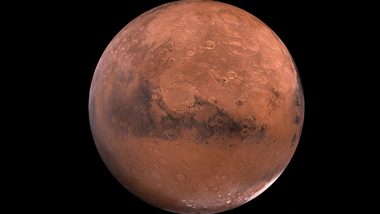Washington, December 17: The largest earthquake ever detected on Mars has revealed layers in its crust that could indicate past collision with a massive object, such as a meteoroid. Previous data have suggested the past occurrence of a large impact, and the findings offer evidence that might support this hypothesis.
The research, led by UCLA planetary scientists and published in two papers in Geophysical Research Letters, could also indicate that alternating layers of volcanic and sedimentary rocks lie beneath the surface. South Korea’s Lunar Orbiter ‘Danuri’ Starts Process To Enter Orbit of Moon, 135 Days After Launch: KARI.
The 4.7 magnitude earthquake, or marsquake, happened in May 2022 and lasted more than four hours, releasing five times more energy than any previously recorded quake. Though moderate by Earth standards, the temblor was nonetheless powerful enough to send seismic surface waves completely around the planet's circumference, the first time this phenomenon has been observed on Mars.
The readings were taken from InSight, which landed on Mars in 2018. InSight is the first outer space seismometer to study in-depth the "inner space" of Mars: its crust, mantle and core. Year Ender 2022: From Zombie Virus Discovery to Elon Musk Twitter Takeover and Creation of Artificial Sun, List of Mega Events of Tech and Science World.
"The seismometer aboard the InSight lander has recorded thousands of marsquakes but never one this large, and it took over three years after landing to record it," said corresponding author Caroline Beghein, a professor of Earth, planetary and space sciences. "This quake generated different kinds of waves, including two types of waves trapped near the surface. Only one of those two has been observed on Mars before, after two impact events, never during a marsquake."
Mapping the seismic activity, the location and frequency of impacts on Mars and the interior structure is important for future missions to the red planet as it will inform scientists and engineers where and how to build structures to ensure the safety of future human explorers.
As on Earth, studying how seismic waves travel through rocks can give scientists clues about the temperature and composition of the planet below the surface that help inform the search for underground water or magma. It also helps scientists understand the past forces that shaped the planet.
Beghein's group combined measurements from two types of surface waves, called Love and Rayleigh waves, to infer the speed of underground shear-waves, which travel horizontally and move rocks perpendicular to the direction of wave propagation. This is the first time Love waves have been observed in conjunction with Rayleigh waves on Mars.
The measurements showed that the shear-waves move faster in the crust when rocks between 10 and 25 kilometers underground oscillate in a direction almost parallel to the planet surface than if the rocks vibrate in the vertical direction. "This wave speed information is related to deformations inside the crust," Beghein said. "Alternating volcanic rocks and sedimentary layers, which were deposited long ago, or a very large impact, such as a meteoroid, most likely account for the seismic wave measurements we observed."
(This is an unedited and auto-generated story from Syndicated News feed, LatestLY Staff may not have modified or edited the content body)













 Quickly
Quickly





















